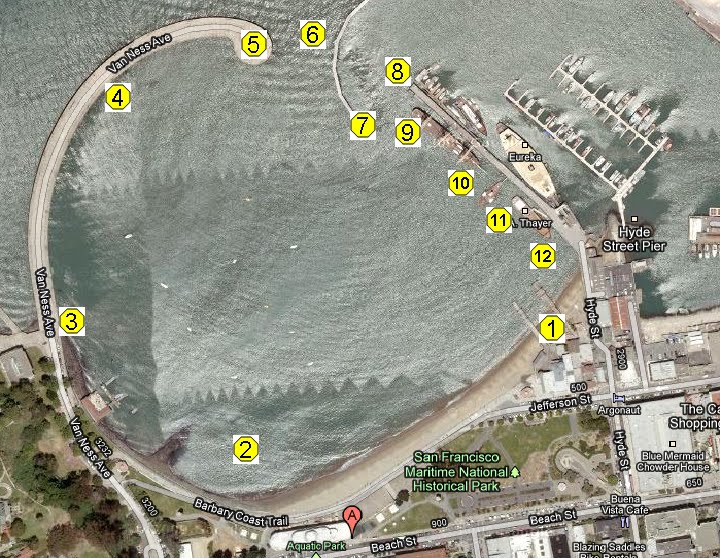Monday 05/31/10
The mystery is solved. Cliff Golding is the Channel swimmer who taught me about the psychological tool for surviving an attack of debilitating doubt in the middle of a long, cold swim. Fortunately for me and the rest of the marathon swimming world, he recently updated his handbook for swimming the English Channel and posted it on the channel swimmers chat site.
According to Swim Trek, "in 1981 Mr. Golding was a twenty-six year old, very contented endurance athlete. Then he took up Channel swimming and ruined his life.” His handbook belongs on the “must read” list for swimmers preparing to attempt a solo English Channel crossing. It covers almost every practical aspect of the swim from boarding to re-boarding the pilot boat. He has graciously permitted republication of this material.
Alison Streeter, MBE, has completed forty-three successful solo crossings of the English Channel, more than any other woman. For this accomplishment, she carries the title, “Queen of the Channel.” Ms. Streeter has famously declared that “Channel swimming is 80% mental, 20% the rest.” In light of this piece of wisdom, I have excerpted the following psychological tips from Mr. Golding’s handbook:
“Now the heavy bit!
There will/might come a stage when you way are out of your comfort zone, having exceeded the longest time previously spent in the water and think the task is now beyond you. Or you might think this early in the swim. Or it might happen when a lot of swimmers hit a rough patch – around the 5-7 hour mark. This is normal. I say again – this is normal!!!!! Oh yes, this is so normal!
I have two hard learnt theories pertaining to Channel swimming. The first is that women are inherently mentally tougher than men! There you go, I’ve said it – and not for the first time! I don’t wish to be too general, but when a man goes to the edge and topples over he can fall into an abyss of despair and stress. If others have witnessed this mental implosion the situation is exacerbated ten fold as far as he is concerned. If a man boos his leg off and calls for his mummy then it can be game over! I never booed or cried for mum in my early days of Channel swimming but I did implode mentally in spectacular fashion and this mental falling apart was, for me, shameful and insurmountable (mad, hey?). Women, on the other hand, are different. Not always, but, in most cases, when a women falls over the edge, she boos her leg off and then gets on with it with a, “So what? Never seen a girl cry before?” defiance.
The shame and insurmountable odds I referred to lead to the second theory which applies to both men and women. I believe we all have secret doors in our heads. When we do long, meaningful swims in training or, ‘on the day’, we can crash headfirst into these secret doors when our task seems beyond us. They are double, triple bolted and have huge mounds of debris in front of them. This debris is not the debris of the swim or the day but of our other, day to day, life. It took me 5 years and 6 Channel attempts in the early nineties (doh!) to realise that I could shift this debris and break down the doors.
The first time I pushed through the ‘secret door’ was one of the most empowering, most enlightening experiences of my life. My whole world, my whole existence, seemed calmer and friendlier. It was then that I realised it was OK to be shit scared, that this gut wrenching paralysis was surmountable. Indeed, instead of fearing fear I saw that it was actually something to acknowledge and embrace and respect. And, guess what? You CAN go beyond your previous limits and succeed - ‘cos, if I did …………!
The reason for this quite revealing section is to tell you that when it hits you (some people deny ever feeling scared or mentally bereft during their Channel swim but I don’t believe a word of it!) let it happen. And don’t be surprised if it hits you early on and more than once. If it does, just move the debris again and open the secret door.
Each swim I do I get hit by the demons again. They don’t announce their arrival, it can be after 1 hour or 6, but once they hit me it’s full on. They burrow and forage and worm their way in, feeding on my fear and trying to get me to quit. And they talk to me!!! 'Go on,' they say. 'The ladder’s just there. Touch it, feel the warmth of a helping hand. We have hot soup and warm clothes and a bed for you to sleep in.' They’re buggers the lot of them. I despise and hate them. Sometimes they gain ground and I have a torrid time but at least I know what to do now.
Be assured, you will be scared - in training, in the lead up and, especially, on the day. Slow or fast, young or old, you will have doubts and wonder what ever inspired you to take this crazy gig. But, crucially, you are not alone. Everyone, to one degree or another, is going through the same angst, I promise. You CAN push through the pain and self doubt. Just unlock the secret door!
When you land it is amazing. Your life will change from that moment – guaranteed. Whatever journey you have taken to get there, and whatever trials and tribulations you encountered on the way, to achieving your dream, you now have the right to call yourself a Channel swimmer. WOW! How cool is that?
WELL DONE! WELL DONE! WELL DONE! WELL DONE! WELL DONE! WELL DONE! WELL DONE! WELL DONE!!!!!!!!!!!!!!!!!!!!”
4 years ago

